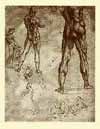|
Biography 1500-1519
"I love those who can smile in trouble, who can gather strength from distress, and grow brave by reflection. 'Tis the business of little minds to shrink, but they whose heart is firm, and whose conscience approves their conduct, will pursue their principles unto death."
-- Leonardo Da Vinci
Second Florentine Period
Around the year 1500, Leonardo decided to leave Milan and head back to
Florence where his good reputation had him readily received by the city.
By 1502 Da Vinci had entered the service of Cesare Borgia, the much-feared
son of Pope Alexander the VI, as senior military architect and general
engineer. This position had him travelling and surveying the surrounding
lands, at which time Leonardo had sketched some city plans and early maps.
 Leonardo
Da Vinci returned to Florence once more in 1503, at which time he was
commissioned to paint a mural in the council hall in Florence's Palazzo
Vecchio. The wall across was commissioned to Leonardo's rival, Michelangelo, who never completed his piece. Leonardo's work, entitled The Battle of Anghiari, which was never completed either, would have measured 23 x 56 feet, double the size of The Last Supper. While working
on this piece, the French governor of Milan hired Leonardo, and once again
Da Vinci abandoned his project to begin employment elsewhere.
Leonardo
Da Vinci returned to Florence once more in 1503, at which time he was
commissioned to paint a mural in the council hall in Florence's Palazzo
Vecchio. The wall across was commissioned to Leonardo's rival, Michelangelo, who never completed his piece. Leonardo's work, entitled The Battle of Anghiari, which was never completed either, would have measured 23 x 56 feet, double the size of The Last Supper. While working
on this piece, the French governor of Milan hired Leonardo, and once again
Da Vinci abandoned his project to begin employment elsewhere.
Before leaving, Leonardo accepted a commission from a wealthy Florentine merchant who wanted a portrait of his wife, Mona Lisa. From 1503-1506 Leonardo Da Vinci completed one of the most renowned works of all time, The Mona Lisa. Many scholars doubt the story of the merchant and the commission, and there are several conflicting stories about who the woman in the painting really may have been. However, the mystery behind the painting is shadowed by the genius of the work that is now seen by thousands of tourists each day at the Louvre in Paris. The painting is available today as a popular Da Vinci poster and has also been transformed into numerous novelty items.
Second Milanese Period
In 1506 Leonardo traveled back to Milan to work for the French governor
of Milan, Charles d'Amboise. During his time there, Leonardo Da Vinci
created few paintings, and acted mainly as an architect. Some of his sketches
from this period have survived and are sold alongside the many other Da
Vinci posters.
Besides his work for the governor, during this time Da Vinci underwent extensive research on the human anatomy.
Final Years
In 1513 the French were expelled from Milan, forcing Leonardo to seek
work outside the city. Da Vinci headed to Rome where his friend, Giuliano
de'Medici, the brother of the Pope Leo X, offered him living space in
his residence in the Vatican.
For about three years, Leonardo stayed in Rome, and did not receive any commissions, while his rivals, Michelangelo and Raphael, where hard at work.
By 1516 the king of France, Francis I, requested that Leonardo join his service. At this time, Leonardo chose to leave Italy, his native country, where he would never return again. He bore the title of "First painter, architect, and engineer to the King," and he lived in the small town of Cloux, near the king's palace.
At the age of 67, in 1519, while living in France, Leonardo Da Vinci died and was buried in the church of Saint-Florentin. The church was ruined during the French Revolution, and completely torn down during the 19th Century. Today, there are no markings to identify Leonardo's gravesite. The Renaissance Master, as he is often referred to, continues to live on through his surviving paintings, his many notebooks and through the extensive selection of Da Vinci posters and prints that have been produced over the years.
See another Leonardo Da Vinci biography on www.leonardodavinci.net.
